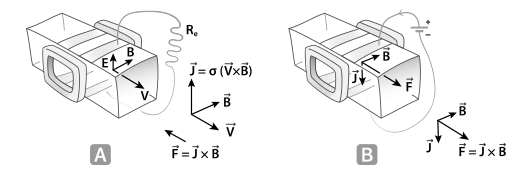A magnetohydrodynamic converter (MHD converter) is an electromagnetic machine with no moving parts involving magnetohydrodynamics, the study of the kinetics of electrically conductive fluids (liquid or ionized gas) in the presence of electromagnetic fields. Such converters act on the fluid using the Lorentz force to operate in two possible ways: either as an electric generator called an MHD generator, extracting energy from a fluid in motion; or as an electric motor called an MHD accelerator or magnetohydrodynamic drive, putting a fluid in motion by injecting energy. MHD converters are indeed reversible, like many electromagnetic devices.[1]
Michael Faraday first attempted to test a MHD converter in 1832. MHD converters involving plasmas were highly studied in the 1960s and 1970s, with many government funding and dedicated international conferences. One major conceptual application was the use of MHD converters on the hot exhaust gas in a coal fired power plant, where it could extract some of the energy with very high efficiency, and then pass it into a conventional steam turbine. The research almost stopped after it was considered the electrothermal instability would severely limit the efficiency of such converters when intense magnetic fields are used,[2] although solutions may exist.[3][4][5][6]

(linear Faraday type with segmented electrodes)
- ^ Petit, Jean-Pierre (1983). The Silence Barrier (PDF). The Adventures of Archibald Higgins. Savoir Sans Frontières.
- ^ Velikhov, E. P.; Dykhne, A. M.; Shipuk, I. Ya (1965). Ionization instability of a plasma with hot electrons (PDF). 7th International Conference on Ionization Phenomena in Gases. Belgrade, Yugoslavia.
- ^ Shapiro, G. I.; Nelson, A. H. (12 April 1978). "Stabilization of ionization instability in a variable electric field". Pis'ma V Zhurnal Tekhnischeskoi Fiziki. 4 (12): 393–396. Bibcode:1978PZhTF...4..393S.
- ^ Murakami, T.; Okuno, Y.; Yamasaki, H. (December 2005). "Suppression of ionization instability in a magnetohydrodynamic plasma by coupling with a radio-frequency electromagnetic field" (PDF). Applied Physics Letters. 86 (19): 191502–191502.3. Bibcode:2005ApPhL..86s1502M. doi:10.1063/1.1926410.
- ^ Petit, J.-P.; Geffray, J. (June 2009). "Non equilibrium plasma instabilities". Acta Physica Polonica A. 115 (6): 1170–1173. Bibcode:2009AcPPA.115.1170P. doi:10.12693/aphyspola.115.1170.
- ^ Petit, J.-P.; Doré, J.-C. (2013). "Velikhov electrothermal instability cancellation by a modification of electrical conductivity value in a streamer by magnetic confinement". Acta Polytechnica. 53 (2): 219–222. doi:10.14311/1765. hdl:10467/67041.